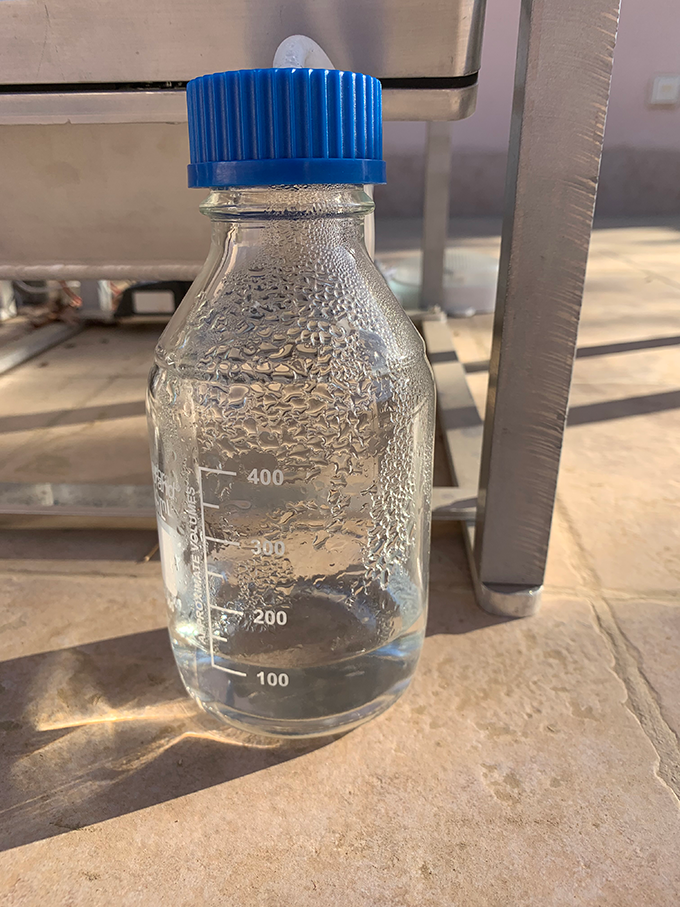Clean energy and water. Persons require both. Unfortunately, millions of people worldwide lack dependable access to either. An innovative water-collecting solar panel system, however, may offer these resources and ought to function wherever, including in isolated deserts.
The new system has been led by environmental scientist Peng Wang. Its creation was influenced by his upbringing. Wang’s family had to go to a community well to get water because their home in Western China did not have a running water supply. Now, areas like the one where he was raised could have access to both water and electricity thanks to his new water-collecting solar panel technology.
Wang is employed by KAUST, the King Abdullah University of Science and Technology. Thuwal, Saudi Arabia, is where it is. Wang is a member of a group that has been striving to improve the effectiveness of solar panels. Along the way, this researchers also created a hydrogel, a water-based material. This unique hybrid substance may draw fresh water from even air that initially appears to be dry when coupled with salt.
To capture the sun’s rays and generate electricity, Wang’s team employed solar panels that collected water. Each of those panels was supported with the brand-new hybrid hydrogel. Moisture gathered by the backing material is stored in a metal chamber that is coupled to the system. The solar panels can be cooled down using that water, which will increase their output of power. Alternatively, water can slake the thirst of both people and plants.
During a three-month experiment last summer, Wang and his colleagues tested the device in the sweltering Saudi sun. Per square meter of solar panel, the apparatus gathered on average 0.6 liter (2.5 cups) of water every day. The size of each solar panel used to gather water was roughly 2 square meters (21.5 square feet). Therefore, a family would require roughly two solar panels to supply the household’s needs for drinking water for each member. Even more water would be needed for food production.
Soaking up sun — and water
Even though it sometimes appears otherwise, the atmosphere of the Earth is moist. According to Wang, the world’s air contains “six times the amount of water in all rivers on Earth.” It’s a lot, that!
Many techniques to access this water necessitate moist air, such as those found in damp or foggy environments. Others are powered by electricity. Both are not needed by the new KAUST system. Its hybrid hydrogel collects water at night, when the air is cooler and more humid, and stores it, much like a paper towel does. The hydrogel-based substance is warmed by the same daytime sun that powers the water-collecting solar panels. The heated substance forces the water that has been stored there into the collection chamber.
 This container contains some of the water that was gathered by the innovative solar and water system that Saudi Arabian researchers are developing. LI/KAUST, R.
This container contains some of the water that was gathered by the innovative solar and water system that Saudi Arabian researchers are developing. LI/KAUST, R.There are two operating modes for the new system. In the first, it cools the solar panels using the moisture it has gathered. (Cooler panels can more effectively convert solar energy into electricity.) Or, the collected water can be utilized to water plants and for drinking. How each water-collecting solar panel uses the water it has collected depends on whether a chamber beneath it is open or closed.
According to Wang, the water-collecting solar panel cooling mode “is analogous to human sweating.” “When it’s hot outside or when we exercise, we sweat to lower our body temperature.” As perspiration evaporates, the water in it removes heat from our bodies. The water that is kept on the solar panels’ backs can also pick up heat from the panels when it evaporates.
The solar panels were cooled by up to 17 degrees Celsius in this mode (30 degrees Fahrenheit). The panels’ power output increased by 10% as a result. A person would require fewer solar panels to operate in this mode.
Water vapor condenses out of the hybrid hydrogel and drips into a storage chamber in the system’s water-collecting mode. The power production of the water-collecting solar panels is still increased in this mode, but only by a little, by about 1.4 to 1.8 percent.
The water spinach crop was grown using Wang’s team’s apparatus during the trial that took place last summer. 60 seeds were sown by the researchers. Nearly all of the seeds—19 out of every 20—grew into plants when protected from the sweltering summer sun and given daily water from the atmosphere.
The system shows promise
Jackson Lord describes the initiative as “interesting.” He works with AltoVentus in San Francisco, California, as a consultant for renewable energy and environmental technology. Earlier in his career, he worked with the Mountain View, California-based X-The Moonshot Factory and studied the process of gathering water from the air.
The new method, according to Lord, “can create clean water anyplace,” he says. However, he believes that this kind of technology is more appropriate for producing drinking water than for raising food. He argues that in arid areas, there is typically not enough water in the air to support large fields of crops.
However, Lord argues that it’s crucial to design systems like these that take advantage of underutilized resources, whether that means extracting water from the air or using surplus heat for productive purposes. He adds that since the system increases the output of a standard solar panel, its capacity to store water for drinking or for use in growing crops might be seen as an added benefit that can be used as needed.
Wang points out that this invention is still in its infancy. He plans to work with partners to improve the system and make it available all over the world.


